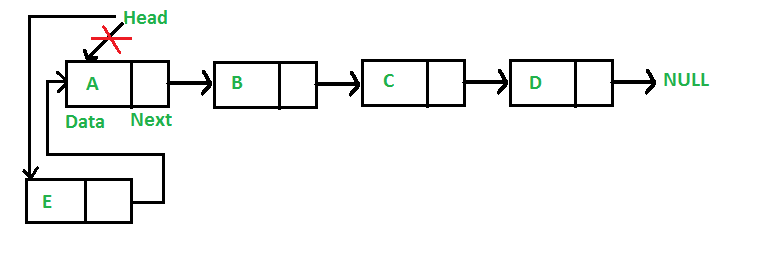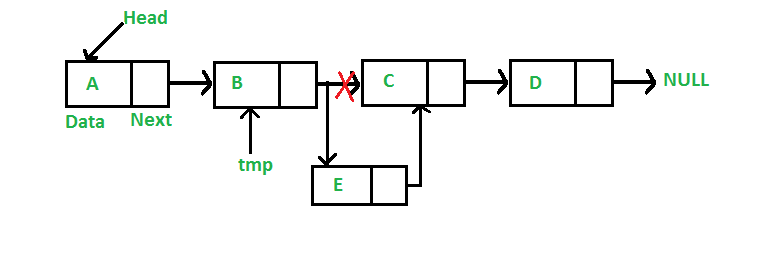Given a Linked List, the task is to insert a new node in this given Linked List at the following positions:
- At the front of the linked list
- After a given node.
- At the end of the linked list.
Approach:
To insert a node at the start/beginning/front of a Linked List, we need to:
- Make the first node of Linked List linked to the new node
- Remove the head from the original first node of Linked List
- Make the new node as the Head of the Linked List.

Below is the implementation of the approach:
C++
void push(Node** head_ref, int new_data)
{
Node* new_node = new Node();
new_node->data = new_data;
new_node->next = (*head_ref);
(*head_ref) = new_node;
}
|
C
void push(struct Node** head_ref, int new_data)
{
struct Node* new_node
= (struct Node*)malloc(sizeof(struct Node));
new_node->data = new_data;
new_node->next = (*head_ref);
(*head_ref) = new_node;
}
|
Java
public void push(int new_data)
{
Node new_node = new Node(new_data);
new_node.next = head;
head = new_node;
}
|
Python3
def push(self, new_data):
new_node = Node(new_data)
new_node.next = self.head
self.head = new_node
|
C#
public void push(int new_data)
{
Node new_node = new Node(new_data);
new_node.next = head;
head = new_node;
}
|
Javascript
<script>
function push(new_data)
{
var new_node = new Node(new_data);
new_node.next = head;
head = new_node;
}
</script>
|
Complexity Analysis:
- Time Complexity: O(1), We have a pointer to the head and we can directly attach a node and change the pointer. So the Time complexity of inserting a node at the head position is O(1) as it does a constant amount of work.
- Auxiliary Space: O(1)
Refer this post for detailed implementation of the above approach.
Approach:
To insert a node after a given node in a Linked List, we need to:
- Check if the given node exists or not.
- If it do not exists,
- If the given node exists,
- Make the element to be inserted as a new node
- Change the next pointer of given node to the new node
- Now shift the original next pointer of given node to the next pointer of new node

Below is the implementation of the approach:
C++
void insertAfter(Node* prev_node, int new_data)
{
if (prev_node == NULL) {
cout << "The given previous node cannot be NULL";
return;
}
Node* new_node = new Node();
new_node->data = new_data;
new_node->next = prev_node->next;
prev_node->next = new_node;
}
|
C
void insertAfter(struct Node* prev_node, int new_data)
{
if (prev_node == NULL) {
printf("the given previous node cannot be NULL");
return;
}
struct Node* new_node
= (struct Node*)malloc(sizeof(struct Node));
new_node->data = new_data;
new_node->next = prev_node->next;
prev_node->next = new_node;
}
|
Java
public void insertAfter(Node prev_node, int new_data)
{
if (prev_node == null) {
System.out.println(
"The given previous node cannot be null");
return;
}
Node new_node = new Node(new_data);
new_node.next = prev_node.next;
prev_node.next = new_node;
}
|
Python3
def insertAfter(self, prev_node, new_data):
if prev_node is None:
print("The given previous node must inLinkedList.")
return
new_node = Node(new_data)
new_node.next = prev_node.next
prev_node.next = new_node
|
C#
public void insertAfter(Node prev_node, int new_data)
{
if (prev_node == null) {
Console.WriteLine("The given previous node"
+ " cannot be null");
return;
}
Node new_node = new Node(new_data);
new_node.next = prev_node.next;
prev_node.next = new_node;
}
|
Javascript
<script>
function insertAfter(prev_node, new_data)
{
if (prev_node == null)
{
document.write("The given previous node cannot be null");
return;
}
var new_node = new Node(new_data);
new_node.next = prev_node.next;
prev_node.next = new_node;
}
</script>
|
Complexity Analysis:
- Time complexity: O(1), since prev_node is already given as argument in a method, no need to iterate over list to find prev_node
- Auxiliary Space: O(1) since using constant space to modify pointers
Refer this post for detailed implementation of the above approach.
Approach:
To insert a node at the end of a Linked List, we need to:
- Go to the last node of the Linked List
- Change the next pointer of last node from NULL to the new node
- Make the next pointer of new node as NULL to show the end of Linked List

Below is the implementation of the approach:
C++
void append(Node** head_ref, int new_data)
{
Node* new_node = new Node();
Node* last = *head_ref;
new_node->data = new_data;
new_node->next = NULL;
if (*head_ref == NULL) {
*head_ref = new_node;
return;
}
while (last->next != NULL) {
last = last->next;
}
last->next = new_node;
return;
}
|
C
void append(struct Node** head_ref, int new_data)
{
struct Node* new_node
= (struct Node*)malloc(sizeof(struct Node));
struct Node* last = *head_ref;
new_node->data = new_data;
new_node->next = NULL;
if (*head_ref == NULL) {
*head_ref = new_node;
return;
}
while (last->next != NULL)
last = last->next;
last->next = new_node;
return;
}
|
Java
public void append(int new_data)
{
Node new_node = new Node(new_data);
if (head == null) {
head = new Node(new_data);
return;
}
new_node.next = null;
Node last = head;
while (last.next != null)
last = last.next;
last.next = new_node;
return;
}
|
Python3
def append(self, new_data):
new_node = Node(new_data)
if self.head is None:
self.head = new_node
return
last = self.head
while (last.next):
last = last.next
last.next = new_node
|
C#
public void append(int new_data)
{
Node new_node = new Node(new_data);
if (head == null) {
head = new Node(new_data);
return;
}
new_node.next = null;
Node last = head;
while (last.next != null)
last = last.next;
last.next = new_node;
return;
}
|
Javascript
<script>
function append(new_data)
{
var new_node = new Node(new_data);
if (head == null)
{
head = new Node(new_data);
return;
}
new_node.next = null;
var last = head;
while (last.next != null)
last = last.next;
last.next = new_node;
return;
}
</script>
|
Complexity Analysis:
- Time complexity: O(N), where N is the number of nodes in the linked list. Since there is a loop from head to end, the function does O(n) work.
- This method can also be optimized to work in O(1) by keeping an extra pointer to the tail of the linked list/
- Auxiliary Space: O(1)
Refer this post for detailed implementation of the above approach.
Feeling lost in the world of random DSA topics, wasting time without progress? It's time for a change! Join our DSA course, where we'll guide you on an exciting journey to master DSA efficiently and on schedule.
Ready to dive in? Explore our Free Demo Content and join our DSA course, trusted by over 100,000 geeks!